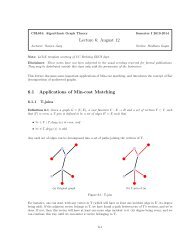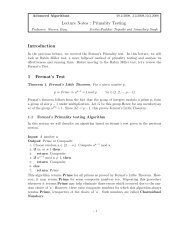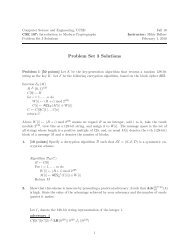A short proof of the Berge–Tutte Formula and the Gallai–Edmonds ...
A short proof of the Berge–Tutte Formula and the Gallai–Edmonds ...
A short proof of the Berge–Tutte Formula and the Gallai–Edmonds ...
Create successful ePaper yourself
Turn your PDF publications into a flip-book with our unique Google optimized e-Paper software.
A <strong>short</strong> <strong>pro<strong>of</strong></strong> <strong>of</strong> <strong>the</strong> <strong>Berge–Tutte</strong> <strong>Formula</strong> <strong>and</strong> <strong>the</strong><br />
<strong>Gallai–Edmonds</strong> Structure Theorem<br />
Douglas B. West ∗<br />
Abstract<br />
We present a <strong>short</strong> <strong>pro<strong>of</strong></strong> <strong>of</strong> <strong>the</strong> <strong>Berge–Tutte</strong> <strong>Formula</strong> <strong>and</strong> <strong>the</strong> <strong>Gallai–Edmonds</strong><br />
Structure Theorem from Hall’s Theorem.<br />
The fundamental <strong>the</strong>orems on matchings in graphs have been proved in many ways. The<br />
most famous <strong>of</strong> <strong>the</strong>se results is Hall’s Theorem [6], characterizing when a bipartite graph has<br />
a matching that covers one partite set. Anderson [1] used Hall’s Theorem to prove Tutte’s 1-<br />
Factor Theorem [9], characterizing when a graph has a perfect matching. Berge [2] extended<br />
Tutte’s 1-Factor Theorem to a min-max formula (known as <strong>the</strong> <strong>Berge–Tutte</strong> <strong>Formula</strong>) for<br />
<strong>the</strong> maximum size <strong>of</strong> a matching in a general graph.<br />
In fact, Anderson’s approach proves <strong>the</strong> <strong>Berge–Tutte</strong> <strong>Formula</strong> as easily as it proves Tutte’s<br />
1-Factor Theorem. Using <strong>the</strong> <strong>Berge–Tutte</strong> <strong>Formula</strong>, it <strong>the</strong>n also yields <strong>the</strong> <strong>Gallai–Edmonds</strong><br />
Structure Theorem [3, 4, 5], which describes all <strong>the</strong> maximum matchings in a given graph.<br />
Our <strong>pro<strong>of</strong></strong> by this method is <strong>short</strong>er than earlier inductive <strong>pro<strong>of</strong></strong>s (see Theorem 3.2.1 <strong>of</strong><br />
[8], for example) by not needing a characterization <strong>of</strong> factor-critical graphs or a “Stability<br />
Lemma” (Lemma 3.2.2 in [8]). We are indebted to <strong>the</strong> referee for pointing out <strong>the</strong> paper by<br />
Kotlov [7], which gives ano<strong>the</strong>r <strong>short</strong> <strong>pro<strong>of</strong></strong> along similar lines to that given here.<br />
For a set S <strong>of</strong> vertices in a graph G, let N G (S) or N(S) denote <strong>the</strong> set <strong>of</strong> vertices having<br />
at least one neighbor in S. An X,Y -bigraph is a bipartite graph with partite sets X <strong>and</strong> Y .<br />
A matching is a set <strong>of</strong> pairwise non-incident edges. In an X,Y -bigraph, an obvious necessary<br />
condition for a matching that covers X is that |N(S)| ≥ |S| for all S ⊆ X. This is Hall’s<br />
Condition, <strong>and</strong> Hall’s Theorem [6] states that it is also sufficient.<br />
A 1-factor is a spanning 1-regular subgraph; its edge set is a perfect matching. In a graph<br />
H, let o(H) be <strong>the</strong> number <strong>of</strong> odd components (those having an odd number <strong>of</strong> vertices).<br />
In a graph G, an obvious necessary condition for a 1-factor is that o(G − S) ≤ |S| whenever<br />
S ⊆ V (G). This is Tutte’s Condition; Tutte proved that it is also sufficient.<br />
In a graph G, <strong>the</strong> deficiency def G (S) or def(S) is o(G−S)−|S|. Covering all vertices in an<br />
odd component <strong>of</strong> G−S by a matching in G requires matching one <strong>of</strong> its vertices with a vertex<br />
∗ Department <strong>of</strong> Ma<strong>the</strong>matics, University <strong>of</strong> Illinois, Urbana, IL 61801, west@math.uiuc.edu. This research<br />
is partially supported by <strong>the</strong> National Security Agency under Award No. H98230-10-1-0363.<br />
1
<strong>of</strong> S. A Tutte set is a vertex subset with positive deficiency. Let def(G) = max S⊆V (G) def(S).<br />
In an n-vertex graph G, every matching leaves at least n − def(G) vertices uncovered. By<br />
applying Tutte’s Theorem to <strong>the</strong> graph obtained from G by adding def(G) vertices with no<br />
non-neighbors, Berge observed that <strong>the</strong> maximum size <strong>of</strong> a matching is 1 (n − def(G)).<br />
2<br />
Anderson [1] proved Tutte’s Theorem by applying Hall’s Theorem to a bipartite graph<br />
derived from a maximal set <strong>of</strong> maximum deficiency. We show that <strong>the</strong> same approach directly<br />
yields <strong>the</strong> <strong>Berge–Tutte</strong> <strong>Formula</strong>. It also yields a <strong>short</strong> <strong>pro<strong>of</strong></strong> <strong>of</strong> <strong>the</strong> <strong>Gallai–Edmonds</strong> Structure<br />
Theorem, which describes all <strong>the</strong> maximum-sized matchings in a graph G.<br />
The first two lemmas are well known; we include <strong>the</strong>m for completeness.<br />
Lemma 1 (Parity Lemma) If G is an n-vertex graph <strong>and</strong> S ⊆ V (G), <strong>the</strong>n o(G−S)−|S| ≡ n<br />
mod 2. In particular, if S is a Tutte set <strong>and</strong> n is even, <strong>the</strong>n o(G − S) ≥ |S| + 2.<br />
Pro<strong>of</strong>. Counting vertices shows that o(G − S) + |S| ≡ n mod 2.<br />
□<br />
Lemma 2 Let T be a maximal set among <strong>the</strong> vertex sets <strong>of</strong> maximum deficiency in a graph<br />
G. If u is a vertex <strong>of</strong> an odd component C <strong>of</strong> G − T, <strong>the</strong>n <strong>the</strong> graph C − u satisfies Tutte’s<br />
Condition. Also, all components <strong>of</strong> G − T are odd.<br />
Pro<strong>of</strong>. For S ⊆ V (C − u), we have<br />
def G (T ∪ u ∪ S) = o(G − T − u − S) − (|T | + 1 + |S|)<br />
= o(G − T) − 1 + o(C − u − S) − |T | − 1 − |S|<br />
= def G (T) − 2 + def C−u (S)<br />
The choice <strong>of</strong> T yields def G (T ∪ u ∪ S) < def G (T). By <strong>the</strong> Parity Lemma, <strong>the</strong>y have <strong>the</strong><br />
same parity. Hence def C−u (S) ≤ 0. Since S is arbitrary, C − u satisfies Tutte’s Condition.<br />
If G − T has a component with even order, <strong>the</strong>n adding to T any leaf <strong>of</strong> a spanning tree<br />
<strong>of</strong> that component creates a larger set with <strong>the</strong> same deficiency as T.<br />
□<br />
For T ⊆ V (G), define an auxiliary bipartite graph H(T) by contracting each component<br />
<strong>of</strong> G − T to a single vertex <strong>and</strong> deleting edges within T. With Y denoting <strong>the</strong> set <strong>of</strong><br />
components <strong>of</strong> G − T, <strong>the</strong> graph H(T) is a T,Y -bigraph having an edge ty for t ∈ T <strong>and</strong><br />
y ∈ Y if <strong>and</strong> only if t has a neighbor in G in <strong>the</strong> component <strong>of</strong> G − T corresponding to y.<br />
Lemma 3 If T is a maximal set <strong>of</strong> maximum deficiency in a graph G, <strong>the</strong>n H(T) contains<br />
a matching that covers T.<br />
2
Pro<strong>of</strong>. For S ⊆ T, all vertices <strong>of</strong> Y − N H(T) (S) are odd components <strong>of</strong> G − (T − S). By<br />
<strong>the</strong> choice <strong>of</strong> T, we have (|Y | − |N H (S)|) − |T − S| ≤ def(T). Since def(T) = |Y | − |T |,<br />
<strong>the</strong> inequality simplifies to |S| ≤ |N H (S)|. Thus Hall’s Condition holds, <strong>and</strong> H(T) has a<br />
matching that covers T.<br />
□<br />
Edges <strong>of</strong> G corresponding to <strong>the</strong> matching obtained in Lemma 3 match T into vertices <strong>of</strong><br />
distinct odd components <strong>of</strong> G−T. This enables us to build a matching <strong>of</strong> size 1 2 (n−def(G)).<br />
As noted, Tutte’s 1-Factor Theorem is <strong>the</strong> special case d = 0.<br />
Theorem 4 (<strong>Berge–Tutte</strong> <strong>Formula</strong>; Berge [2]). If G is an n-vertex graph, <strong>the</strong>n <strong>the</strong> maximum<br />
size <strong>of</strong> a matching in G is 1 (n − def(G)).<br />
2<br />
Pro<strong>of</strong>. We have noted that 1 (n − def(G)) is an upper bound. To build a matching <strong>of</strong> this<br />
2<br />
size, we use induction on n. The claim is trivial for n = 0; consider n > 0.<br />
Let T be a maximal set with deficiency def(G). By Lemma 2, all components <strong>of</strong> G − T<br />
are odd, <strong>and</strong> C − u satisfies Tutte’s Condition whenever u is a vertex in an odd component<br />
C <strong>of</strong> G − T. By <strong>the</strong> induction hypo<strong>the</strong>sis, C − u has a perfect matching.<br />
Since G − T has |T | + def(G) odd components, it thus suffices to cover T using edges to<br />
distinct components <strong>of</strong> G − T. Lemma 3 guarantees this.<br />
□<br />
In a graph G, let B be <strong>the</strong> set <strong>of</strong> vertices covered by every maximum matching in G, <strong>and</strong><br />
let D = V (G)−B. Fur<strong>the</strong>r partition B by letting A be <strong>the</strong> subset consisting <strong>of</strong> vertices with<br />
at least one neighbor outside B, <strong>and</strong> let C = B − A. The <strong>Gallai–Edmonds</strong> Decomposition<br />
<strong>of</strong> G is <strong>the</strong> partition <strong>of</strong> V (G) into <strong>the</strong> three sets A,C,D.<br />
A graph G is factor-critical if every subgraph obtained by deleting one vertex has a 1-<br />
factor. A matching in G is near-perfect if it covers all but one vertex <strong>of</strong> G. For S ⊆ V (G),<br />
let G[S] denote <strong>the</strong> subgraph <strong>of</strong> G induced by S.<br />
Theorem 5 (<strong>Gallai–Edmonds</strong> Structure Theorem) Let A,C,D be <strong>the</strong> sets in <strong>the</strong> Gallai–<br />
Edmonds Decomposition <strong>of</strong> a graph G. Let G 1 ,...,G k be <strong>the</strong> components <strong>of</strong> G[D]. If M is<br />
a maximum matching in G, <strong>the</strong>n <strong>the</strong> following properties hold.<br />
a) M covers C <strong>and</strong> matches A into distinct components <strong>of</strong> G[D].<br />
b) Each G i is factor-critical, <strong>and</strong> M restricts to a near-perfect matching on G i .<br />
c) If ∅ ≠ S ⊆ A, <strong>the</strong>n N G (S) has a vertex in least |S| + 1 <strong>of</strong> G 1 ,...,G k .<br />
d) def(A) = def(G) = k − |A|.<br />
Pro<strong>of</strong>. Let T be a maximal set <strong>of</strong> deficiency def(G). By <strong>the</strong> <strong>Berge–Tutte</strong> <strong>Formula</strong>, M<br />
leaves def(G) vertices uncovered <strong>and</strong> matches T into vertices <strong>of</strong> distinct components <strong>of</strong> G−T<br />
(all are odd), <strong>and</strong> <strong>the</strong> rest <strong>of</strong> M forms a near-perfect matching in each component <strong>of</strong> G − T.<br />
3
We use T to find <strong>the</strong> sets A,C,D <strong>of</strong> <strong>the</strong> <strong>Gallai–Edmonds</strong> Decomposition. Since H(T)<br />
has a matching covering T (Lemma 3), Hall’s Condition holds: ∣ ∣N H(T) (S) ∣ ≥ |S| for S ⊆ T.<br />
Since ∣ ∣N H(T) (∅) ∣ = 0, we may let R be a maximal subset <strong>of</strong> T for which equality holds.<br />
The crucial point is that C = R ∪ R ′ , where R ′ consists <strong>of</strong> all vertices <strong>of</strong> all components<br />
<strong>of</strong> G − T in N H(T) (R). Since ∣ ∣N H(T) (R) ∣ = |R|, <strong>the</strong> edges <strong>of</strong> M match R into vertices <strong>of</strong><br />
distinct components <strong>of</strong> G[R ′ ]. We have observed that M covers <strong>the</strong> rest <strong>of</strong> R ′ . Since M<br />
covers T <strong>and</strong> no vertex <strong>of</strong> R or R ′ has a neighbor in <strong>the</strong> o<strong>the</strong>r odd components <strong>of</strong> G − T, we<br />
conclude that R ∪ R ′ ⊆ C.<br />
Let D ′ = V (G) − T − R ′ . It suffices to show that D = D ′ <strong>and</strong> A = T − R. That is, we<br />
show that every vertex in D ′ is omitted by some maximum matching <strong>and</strong> that every vertex<br />
<strong>of</strong> T − R has a neighbor in D ′ .<br />
Let H ′ = H(T) −(R ∪N H(T) (R)). For S ⊆ T −R with S nonempty, we have |N H ′(S)| ><br />
|S|, since o<strong>the</strong>rwise R could be enlarged to include S. Therefore, deleting any vertex <strong>of</strong><br />
N H ′(T −R) from H ′ leaves a subgraph <strong>of</strong> H ′ satisfying Hall’s Condition, so H ′ has a maximum<br />
matching omitting any such vertex. By Lemma 2 <strong>and</strong> Theorem 4, each component <strong>of</strong> G−T is<br />
factor-critical, so each vertex in D ′ is avoided by some maximum matching. This completes<br />
(a), (b), <strong>and</strong> (c).<br />
For (d), since o(G[D]) = k, we have def(T) = o(G−T)−|T | = k+|R|−|A ∪ R| = k−|A|.<br />
Since G[C] has a perfect matching, its components have even order, so o(G −A) = k. Hence<br />
A is ano<strong>the</strong>r set with maximum deficiency.<br />
□<br />
References<br />
[1] I. Anderson, Perfect matchings <strong>of</strong> a graph. J. Combinatorial Theory Ser. B 10 (1971),<br />
183–186.<br />
[2] C. Berge, Sur le couplage maximum d’un graphe. C. R. Acad. Sci. Paris 247 (1958),<br />
258–259.<br />
[3] J. Edmonds, Paths, trees, <strong>and</strong> flowers. Canad. J. Math. 17 (1965), 449–467.<br />
[4] T. Gallai, Kritische Graphen II. Magyar Tud. Akad. Mat. Kutató Int. Közl. 8 (1963),<br />
373–395.<br />
[5] T. Gallai, Maximale Systeme unabhängiger Kanten. Magyar Tud. Akad. Mat. Kutató<br />
Int. Közl. 9 (1964), 401–413.<br />
[6] P. Hall, On representatives <strong>of</strong> subsets. J. London Math. Soc. 10 (1935), 26–30.<br />
4
[7] A. Kotlov, Short <strong>pro<strong>of</strong></strong> <strong>of</strong> <strong>the</strong> <strong>Gallai–Edmonds</strong> Structure Theorem,<br />
http://arxiv.org/PS cache/math/pdf/0011/0011204v1.pdf (2000), 3 pages.<br />
[8] L. Lovász <strong>and</strong> M. D. Plummer, Matching Theory. Ann. Discrete Math. Vol. 29, (North-<br />
Holl<strong>and</strong>, Amsterdam), 1986.<br />
[9] W. T. Tutte, The factorization <strong>of</strong> linear graphs. J. London Math. Soc. 22 (1947), 107–<br />
111.<br />
5









